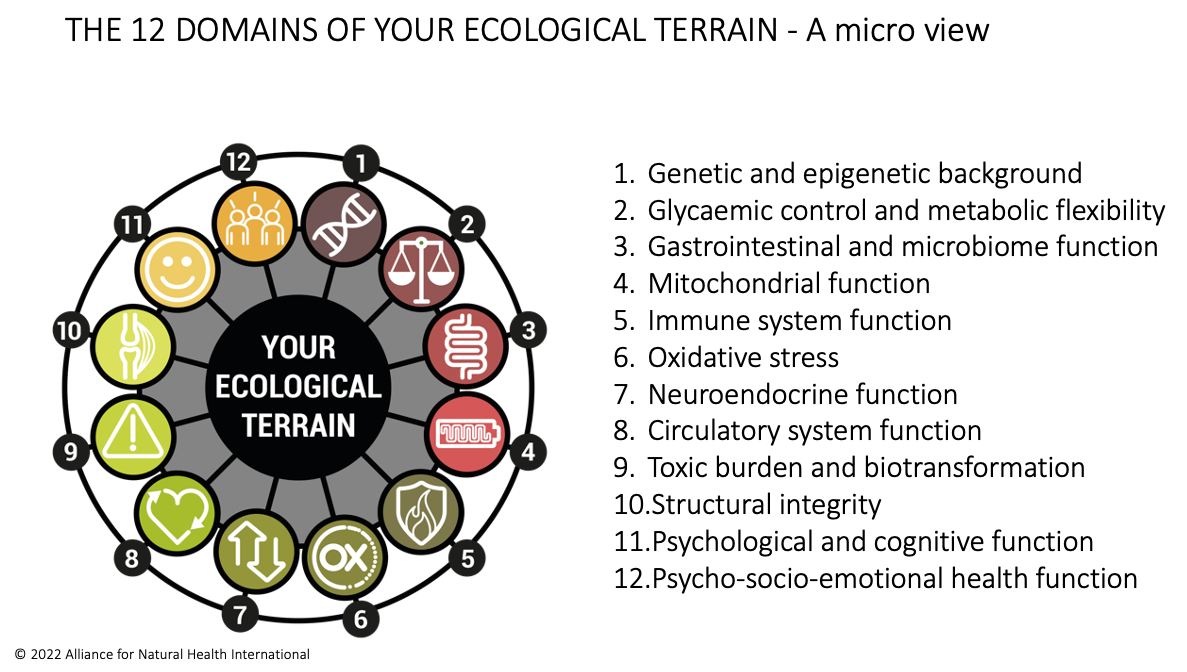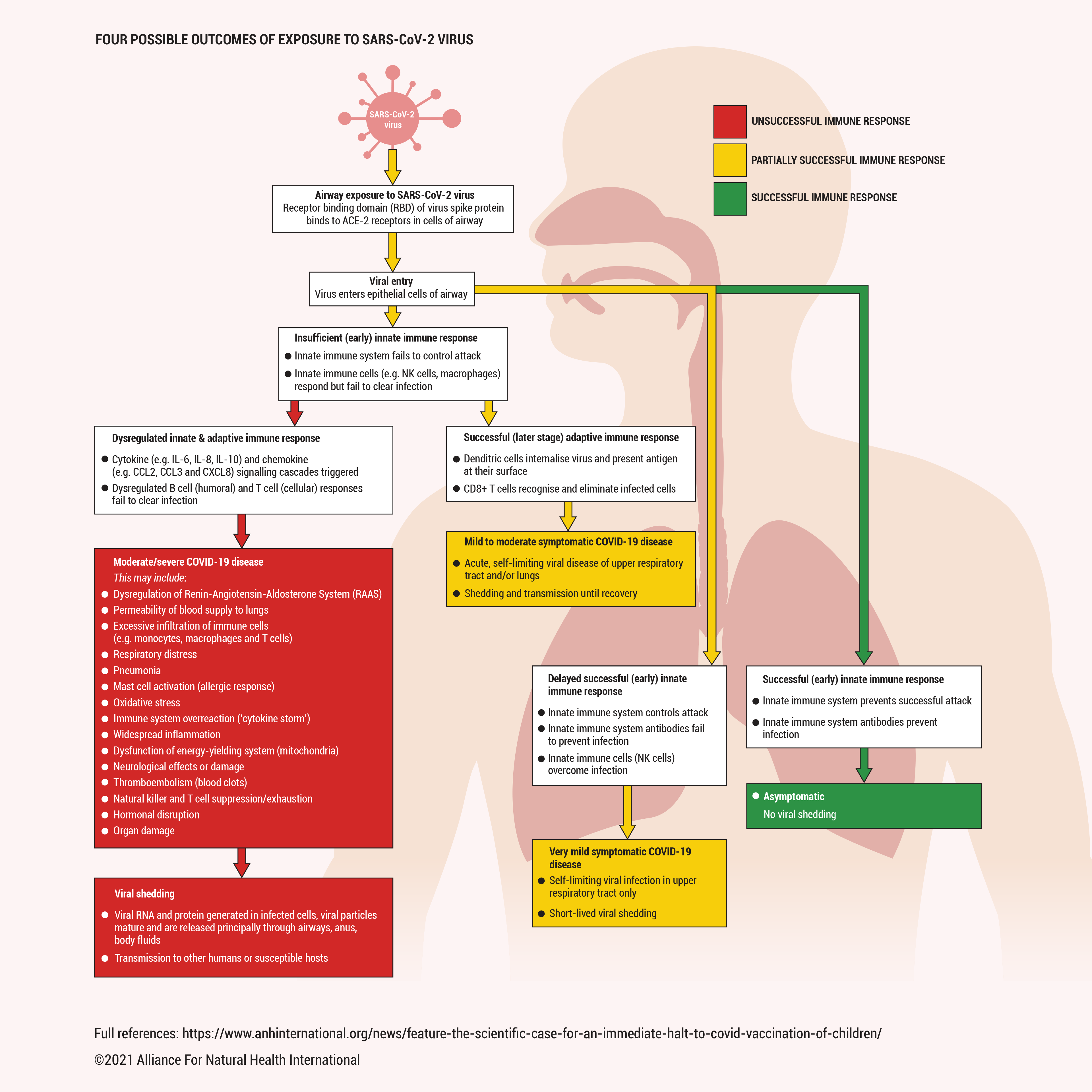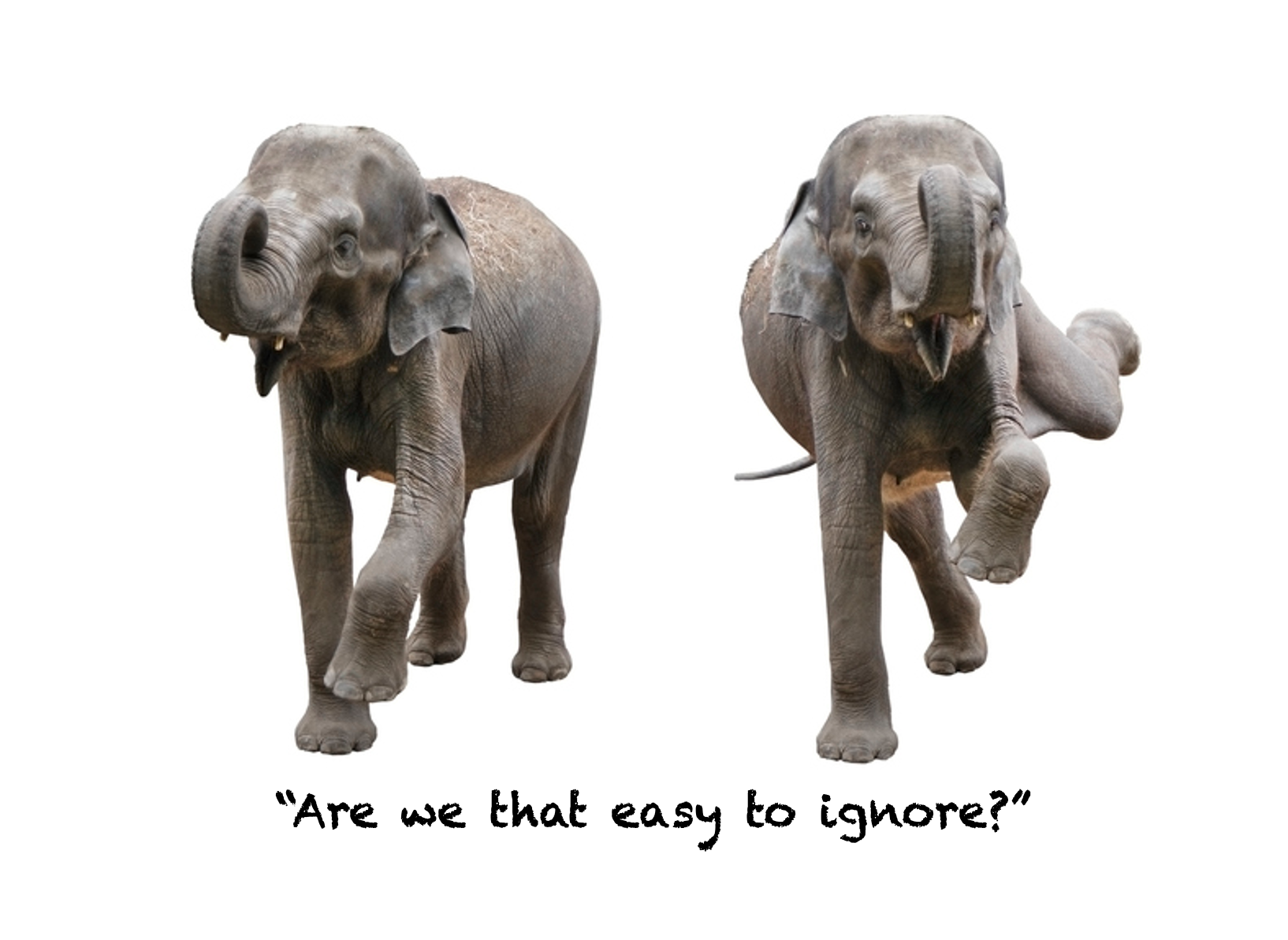Date:20 January 2022
Content Sections
- ● Summary
- ● From the Miasmic Theory to the Germ Theory of Disease
- ● Enter Covid-19…
- ● Exploiting the Germ Theory for Profit
- ● Elephant 1: The Terrain
- ● Covid-19 Outcomes Vary Greatly According to the Terrain
- ● Covid-19: a Highly Stratified Disease
- ● Elephant 2: The Environment
- ● An Opportunity for Self-Empowerment and Sovereignty
- ● Find out more…
By Robert Verkerk MSc DIC PhD FACN
Founder, executive & scientific director, Alliance for Natural Health International
Co-chair, Health & Humanities Committee, World Council for Health
Summary
- When the Miasmic Theory of disease causation was displaced by the Germ Theory in the 19th century, it gave the burgeoning pharmaceutical and vaccine industry an ability to build patented agents for individual pathogens.
- When it comes to infectious diseases, this backdrop has contributed to holding our focus more on the pathogen than on the condition of the host that is susceptible to invasion
- This has been central to most of the measures addressing covid-19 over the last two years – where injections and therapeutics have targeted SARS-CoV-2 and little has been done to address the underlying comorbidities and other factors that drive susceptibility in specific individuals
- There have been two elephants in the room: one is our bodily ‘terrain’ (host resilience) and the internal and external environments to which our bodies are exposed during the course of our lives
- The high level of stratification of covid-19 disease means that susceptible groups can be readily identified and many of the factors contributing to risk are modifiable through specific, individualised health choices and behaviour change
- Moderate, severe or life threatening covid-19 disease is caused by innate and/or adaptive immune failure, which is often associated with multi-system dysfunctions, many of which are modifiable by changes to nutrition, lifestyle and behaviour
- While certain aspects of our environment may be difficult to modify (such as the place we live), others are modifiable (e.g. purification of water, reduced alcohol consumption, air quality improvement, non-toxic personal care products)
- Despite restrictions to our freedom, it is imperative that as many people as possible regain individual sovereignty, bodily autonomy and transition the primary locus of control in health from health authorities, back to the individual and his/her community
- Initiatives have been launched in Canada and the UK to encourage self-empowerment in regenerating whole person health and resilience within communities based on a holistic framework
Note: An abbreviated version of this article will soon be available on the World Council for Health website.
>>> Link for sharing the video: https://odysee.com/@ANHInternational:5/TwoElephants:5?r=56taLS2kpop3MsndMePfz1op4ya7SpYM
From the Miasmic Theory to the Germ Theory of Disease
Throughout most of the 19th century, scientists such as Agostino Bassi in Italy, John Snow in the UK, Louis Pasteur in France, and Robert Koch in Germany, managed to put paid to the Miasmic Theory of disease causation that prevailed up until the 19th century. This theory for how diseases came about crystallised in the 18th century and was an extension of the Humoral Theory originated by Hippocrates and colleagues in Ancient Greece around 400 BC. The theory proposed that diseases like cholera, typhoid, chlamydia and tuberculosis that plagued people in Europe during the Middle Ages, especially in cities and towns, were caused by poisonous emanations or ‘foul air’ – a miasma – from putrefying carcasses, rotting vegetation, moulds and invisible dust particles present inside dwellings, sewers and in other less-than-hygienic places.
While Miasmic Theory drew attention to the link between dirty environments and disease, with proponents including Florence Nightingale, it didn’t stand up to the use of microscopes, Koch’s postulates, or the work of Edward Jenner that culminated in the first vaccines after he showed that infection with cowpox protects against subsequent infection with smallpox.
Germ Theory, attributed in particular to Pasteur, kicked off the discipline we know today as microbiology. It remains an emerging discipline, one that over the last 25 or so years has moved further away from just seeing microbes in relation to their host in terms of their parasitic, pathogenic, commensal or mutually beneficial roles. Instead, there’s a drive to see microbes much more as mediators of evolutionary progression. Yes, viruses, as the most abundant ecological entities on Earth are essential to life – we would not be here without them!
Catalysed by rapid advances in molecular biology, the ‘omics’ sciences and evolutionary ecology, almost every day we learn something new about the integral role played by microorganisms in ensuring human and planetary homeostasis (balance). By contrast, we also learn how human activity and technologies, including the overuse of pharmaceuticals, disrupts that process, to the detriment of some, many or all living things in the longer-term, including ourselves.
Enter Covid-19…
When looking to resolve infectious diseases, we still, it seems, suffer from a Germ Theory hangover. Thinking generally badly about germs encourages the majority of the public, and even many health professionals, to focus almost exclusively on ways of challenging what is perceived to be the ‘bad’ pathogen. In the process, ignoring the status of the host. This hangover has been particularly evident since the discovery of SARS-CoV-2 where a disproportionate amount of governmental, private and public resources has been expended on a single technology; namely novel, experimental gene therapy injections. These don’t have a previous track record of use at scale and they rely largely on only one part of the human immune system (neutralising antibodies produced by B cells) which is forced to respond to one component (the spike protein) of the target pathogen.
The design of these gene therapy treatments relies on delivering genetic information to the body that causes it to produce the cytotoxic spike protein of SARS-CoV-2. It comes with potential drawbacks. These include the possibility for antibody-dependent enhancement of disease (here and here) and the erosion of innate immunity, especially in children who are comparatively more dependent on innate as opposed to adaptive immunity.
Exploiting the Germ Theory for Profit
The Germ Theory has given the pharmaceutical industry, for over 70 years, a perfect backdrop to create products that are marketed as magic bullets for many of the major infectious diseases. The trouble is that there’s actually surprisingly little robust evidence that points either to drugs or vaccines as the main drivers for the decline in infectious diseases – before covid’s arrival, that is. The decline in the prevalence of, and mortality caused by, infectious diseases that occurred during the 20th century was mainly down to changes in sanitation, better hygiene and improved diets.
While we’re made to focus on jabs and novel antivirals and other therapeutic agents that are being rushed through drug company development pipelines in the hope of cashing in on the crisis, there’s little or no talk from public health authorities about the two huge elephants with which we’re sharing the room.
Elephant 1: The Terrain
One of those elephants is ‘the terrain’ of the individual. That’s what’s going on inside each and every one of our unique bodies – the condition of our metabolic, immunological, neurological, cardiovascular, excretory, musculo-skeletal and other systems. And that depends on how our genes have interacted with the environments to which we’ve been exposed during the course of our lives. Enter the field of epigenetics, the discipline that helps us reveal how the inner and external environments to which we’ve been exposed leave permanent changes, or marks, that affect the way our genes express themselves. Over the years, the Terrain Theory of disease causation has had its proponents and advocates, but because its advocacy involves self-empowerment and does not entertain patentable therapeutics, vaccines or gene therapies, it’s never been widely adopted. However, any unbiased interpretation of the current state-of-the-art of science would suggest it is the most relevant theory for a wide range of diseases, especially chronic and degenerative ones. More than that, covid-19 is a perfect example of an infectious disease that exploits sub-optimal terrain.
Our immune competence is intimately linked to our neurological, endocrine (hormonal), metabolic and psychological health, such are the interactions between different bodily pathways and systems. We’ve mapped this into a system of 12 inter-dependent domains that reflect what we call our ‘ecological terrain’ (Fig. 1). Rather than chasing down the symptoms of diseases, particularly chronic diseases, that manifest often months and years after dysfunction in one or more systems occurs, focusing on your ecological terrain let’s you optimise function across all domains. It allows us to move from a disease-centric system of health care, that’s really more about disease management, to real health care which helps us to optimise function across all our major systems. This notion of health creation has more in common with the theory of a rival of Pasteur, another French scientist, Antoine Béchamp, who died largely ignored by the scientific community. Béchamp proposed that the condition (or in current parlance, ‘the terrain’) of an organism, including the presence of beneficial microorganisms (that he referred to more specifically as ‘microzymes’), was more important to that organism’s health than any potential infectious agent, that was the focus of Pasteur.

Figure 1. The 12 domains of the human ‘ecological terrain’ (Source: Alliance for Natural Health International; 2022 update adapted from the ‘Blueprint for health system sustainability in the UK’).
Covid-19 Outcomes Vary Greatly According to the Terrain
Back to covid-19, the infectious disease of our current era, that especially exploits people with dysfunctions across one or more systems. There are four possible outcomes to exposure to SARS-CoV-2, these being dependent on how different parts of our immune system respond (Fig. 2). The best possible outcome is that the infection doesn’t even get a look-in; it is bounced out at the mucosal barrier of our airways before any significant viral replication is able to be initiated internally. Did anyone tell you that vitamin D and the herbs elderberry and Andrographis can help enhance surface defenses?
Next, when people suffer mild, moderate or severe infection, this reflects different levels of failure of first the innate, then the adaptive sides of their immune system. Innate immunity that is initiated in minutes or hours following infection is critical if we want to stop the virus docking with ACE-2 receptors and hijacking the replication machinery of our epithelial cells in our airways and lungs.
Effective trained innate immunity following naturally-acquired infection has been found to be one of the key reasons that children have generally been less susceptible to severe disease from SARS-Cov-2 than adults, especially ones with underlying conditions.
If the innate immune system fails to stop full scale infection of the airways, lungs and lymphatic system, that’s when things can get rocky and where you’re in the hands of the adaptive immune system, comprised of humoral (B cell antibodies) and cell-mediated (T cell) immunity.
Adaptive immunity can take 6 or so days to build with specialised ‘adaptive’ cells like killer T lymphocytes learning how to tackle infected cells that may by now be well distributed within different regions of the body. Unfortunately, this late-developing adaptive immunity can sometimes overreact, leading to hyper-inflammation and cytokine storm which can in turn be sufficient to cause death.
[click on figure below to enlarge]

Figure 2. Four possible outcomes of exposure to SARS-CoV-2 dependent on innate and adaptive immune function (Source: ‘ANH Feature: The scientific case for an immediate halt to covid ‘vaccination’ of children’
Partially, and especially, fully successful immune responses are dependent on a healthy internal and ecological terrain (Fig. 1), which includes a responsive innate immune system, the bit health authorities don’t seem keen to talk about.
Covid-19: a Highly Stratified Disease
Over the last 2 years, we’ve learned a lot about the stratification of covid-19 disease in different population groups. This stratification is good not bad because it makes it much easier to identify groups that need prevention or early treatment compared with if severe disease from SARS-CoV-2 infection afflicted people at random, regardless of age, gender, ethnicity or underlying conditions.
We now see consistent patterns emerging: people who suffer moderate to severe, or life threatening, covid-19 disease, tend to fall into particular groups. They are more likely to be over-65 and male, they’re often from darker skinned ethnicities who don’t get exposed to a lot of sunshine so are deficient in vitamin D, they tend to have a range of underlying conditions such as heart, kidney, neurological and/or lung disease, or they’re immune compromised in one way or another. More to the point, they’re generally not bounding with multi-system resilience and energy before they succumb.
By contrast, people who tend to bounce back quickly following infection have none of these conditions. The multiple systems that comprise their physiological, metabolic and psychological terrain are highly or fully functional. They have what we call excellent resilience (here and here), an ability to bounce back quickly from the challenge of this new pathogenic agent, regardless of the variant to which they’re exposed, as well as any additional psychological stress mediated by restrictive counter-measures imposed by health authorities, governments and private companies.
More than that, to maintain this resilient state, resilient people also tend to engage in particular healthy behaviours; they consume diets that are varied and rich in polyphenols, they sleep well, they move regularly, they use techniques to dissolve negative stress in their lives, their love and security needs are met through their quality social relationships, and they satisfy their higher needs, including having a sense of purpose and meaning in their lives.
We could do so much more to help more people build their resilience by helping them understand that a wide range of modifiable factors are within their control. Instead, we’re told we should pin our hopes on a growing collection of newly patented yet experimental magic bullets, created in a matter of months even when we know it will actually take years to properly understand their full impacts on the long-term health and viability of our species.
Elephant 2: The Environment
You’ve guessed it, the other elephant in the room is ‘the environment’. Our environmental exposures are unique to each and every one of us and they’re also something that may change dramatically during the course of our lives. Our unique environmental exposures in turn create unique imprints on our genotype, switching on or off specific genes, causing some to over or under express the proteins and peptides (chemical messengers) they issue to our bodies.
People who’re healthy and live in healthy environments, who don’t expose themselves to lots of alcohol or polluted air or other toxins, and who manage their exposure to electromagnetic radiation sources from wireless and other digital devices, also tend to do remarkably well in the face of this new pathogen. There’s a huge amount many of us can do to make our environments more favourable. Yet we hear little or nothing about it from the magic bullet protagonists who have too often left us with little more than failed promises and a bunch of harms – so-called side effects.
An Opportunity for Self-Empowerment and Sovereignty
We mustn’t wait to be told to which elements in our terrain and environment we can modify to yield better health outcomes and resilience. Nor should we allow our inalienable right to bodily autonomy to be stolen from us.
Our terrain and many aspects of our environment are already within our control, even if many of our other fundamental rights and freedoms are being taken from us by progressively more authoritarian governments. Too many of us unnecessarily feel we’ve already been disempowered across so many facets of our lives that there’s a risk that we simply give up human rights such as bodily autonomy and informed choice over medical treatments.
The good news is that our health and resilience are modifiable according to many of the choices and behaviours we make during the course of our lives; these often benefiting from guidance and support. These include things like the quality of the food we eat, the water and fluids we drink, the air we breathe, the microorganisms we culture within our bodies and especially in our gut, the chemicals or products we wash and clean with, the social relationships we elect to have in our communities, the way we move physically, rest and sleep, the way we use digital technologies and how we respond psychologically and emotionally to stress and the world around us.
Regardless of what they try to do to us; these domains are still ours to control. As the army of Coalition Partners builds under the umbrella of the World Council for Health, central to our mission is supporting self-empowerment in health. That means we need to really zone in on these two elephants: ‘our terrain’ and ‘our environment’ so we can put ourselves in the driving seat of our own health, regardless of what plans or magic bullets are being cooked up in the board rooms of those few who seem intent, but will fail, to control our destiny.
Find out more…
- ANH-Intl campaign: The Great Health System Reset
- ANH-Intl ‘Adapt Don’t Fight’ covid campaign – over 200 articles and videos since March 2020
- World Council for Health of which ANH-Intl is a Coalition Partner
- Canadian initiative: Ezra Wellness
- UK initiative: My Health Society (Telegram group – website coming soon)
- Lifestyle Medicine 101: Universal Medicine for the 21st Century course accredited by the International College of Regenerative Health facilitated by Rob Verkerk PhD
Proudly affiliated with: Enough Movement Coalition partner of: World Council for Health


